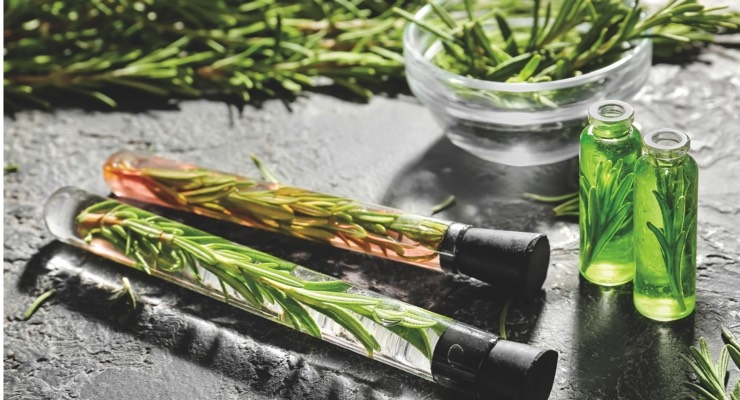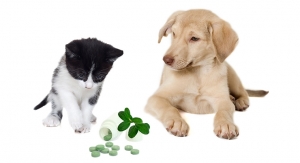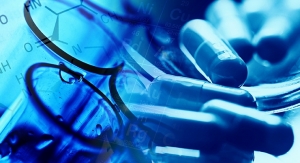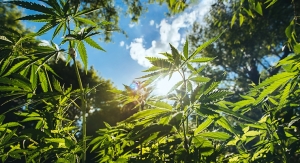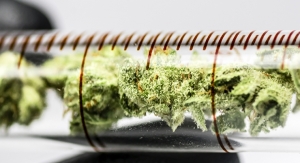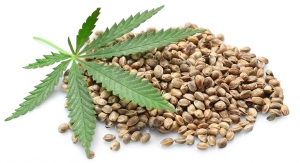By Stephanie Clark, Certified Project Manager, Authenticity Testing, NSF International & Jovan Lubardic, Lab Manager, Authenticity Testing, NSF International04.01.19
Do you know what is in your products? You more than likely have methods in place to confirm your formulations, but how can you know if your quality measures and test methods are thorough enough? While technology moves forward and brings new testing methods to the forefront, it can be daunting to figure out how to use them appropriately. However, knowing what tools are available can be useful in making the best possible decisions on identification of your materials and the quality of the products you are distributing.
Tools of the Trade
Sequencing, as a whole, has presented new opportunities to verify supply chains. Originally, Sanger sequencing brought identification of a single, dominant signal. This dominant signal can be aligned with a reference sequence and compared to determine the identity.1 Sanger sequencing is limited, however, due to its inability to identify anything beyond that single, dominant signal. This testing can act as a confirmation that your material contains the DNA of your target, but additional testing is required to find out if anything beyond the target you are looking for is present in the material.
From Sanger sequencing came next-generation sequencing (NGS). NGS technologies were developed to achieve a higher throughput than traditional Sanger sequencing, meaning that now we can produce thousands, if not millions, of sequences from multiple signals in a single experimental run. Different platforms in next-generation sequencing offer even more variability in the applications of DNA sequencing. Machine outputs can vary between 4 million to 20 billion reads. This quantity isn’t traditionally needed in standard identification but can be critical when looking to sequence a whole genome.
One commonly known method of sequencing is DNA barcoding, which can be used in Sanger and next-generation sequencing. DNA barcoding begins with extracting the DNA from a material and then amplifying target regions of the genome (genes) that will allow differentiation. Those genes are then sequenced for identification. Genes that have been traditionally sequenced for identification of plants include ribulose-1, 5-biphosphate carboxylase (rbcL), and maturase K (matK).2 Choosing the proper gene to identify your sample is imperative to ensure that a sample can be identified. See Figure 1 for an example of when one gene can be right for one genus, but not for another.
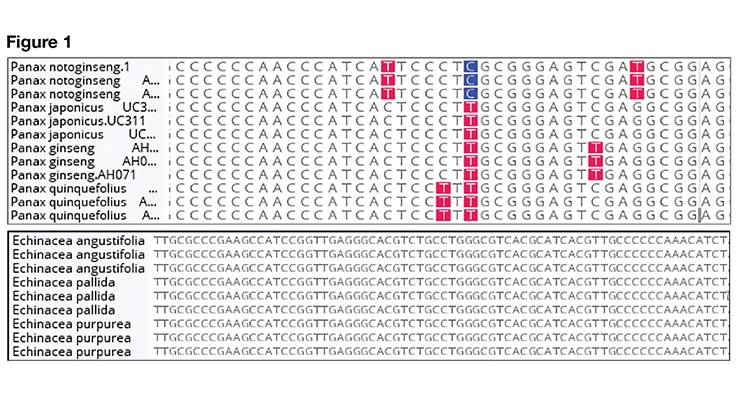
In the internal transcribed spacer region, you can easily distinguish these Panax species from one another. The differences between species are marked with a colored box. On the other hand, you cannot tell these Echinacea species from one another.
Figure 2 shows the exact opposite situation, where if you use maturase K then you are not able to tell the Panax species apart in this region, but you are able to distinguish the Echinacea species. These images were generated in Geneious version 9.1, which is created by Biomatters.
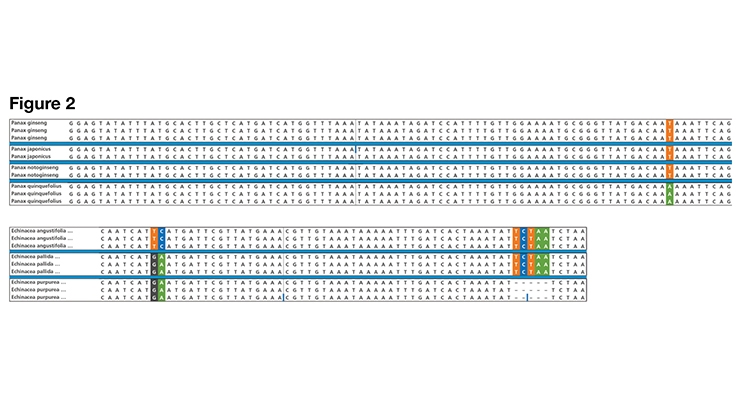
The other limitation, if the correct gene has been selected, is a database that has not been verified or monitored. Sources like GenBank can contain misidentified sequences as Figure 3 shows.
In Figure 3, we have an alignment of Iris species from GenBank, paired with two sequences of specimens from the UC Berkeley Jepson Herbarium. Iris loczyi from GenBank is clearly different from all other Iris samples, and when aligned with Brassica rapa samples from both GenBank and UC Berkeley Jepson Herbarium material, we can see that the sequence aligns perfectly. This demonstrates that not all databases are created equal, just as not all reference materials are created equal. These images were also generated in Geneious version 9.1, which is created by Biomatters.
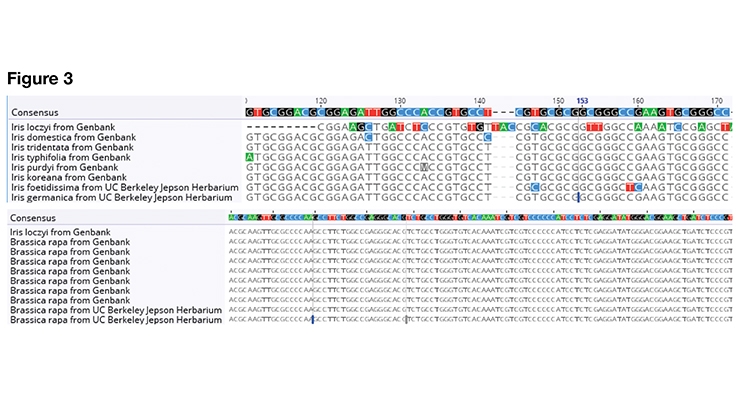
Sanger sequencing and DNA barcoding are not, however, the only means of identifying a sample using sequencing. With the higher throughput of next-generation sequencing, we are able to sequence chloroplast genomes or even entire genomes. Chloroplast genomes have been found to be helpful for the identification of Echinacea in a study conducted by the FDA which may indicate future developments in the sequencing space.3
While the entire genome may not be necessary for identification, taking a deeper look into the genome can provide new information about the history of an organism or can even discover new similarities and differences among species. Long-read sequencing technologies are advancing rapidly, and have already shown significant improvements in costs, portability, and accuracy, which should eventually make whole genome sequencing a more financially feasible option.
Challenges & Solutions
Sequencing, whether it is Sanger, DNA barcoding, next generation or whole genome, has a significant limiting factor—DNA degradation. DNA degradation can occur for a number of reasons, but heat, chemical, or radiation treatments can all be major culprits.
As DNA is exposed to harsh treatments, the chemical bond weakens and ultimately breaks the DNA helix into small fragments, if not completely eliminating the strands. In one study, degradation starts around 130˚ C until complete degradation at 190˚ C. This study only conducted short trials of no more than 5 minutes but still saw significant degradation at high temperatures.4 While there is promise in using smaller genetic regions to identify lightly treated materials, sometimes sequencing is not the best way to identify a material. In these cases, analytical chemistry testing methods should be applied in identifying a specimen.
Chemical testing has a long-established history in authenticating botanicals and raw materials. Of the numerous methodologies available, high-performance thin-layer chromatography (HPTLC) is the primary chemical test for identifying botanicals. This is due to lower cost and higher resolution compared with other tests (HPLC, TLC, etc.).
The HPTLC test outputs a plate with bands unique to the chemical composition of the material being tested, which is then compared to reference standards to identify the material (Figure 4). If there is adulteration, contamination, or substitution in the material, the bands will not match up to the reference plate and more testing will need to be done in order to determine the culprit.5 Similarly, blends of more than one species present a challenge to the HPTLC methodology, as the bands contain more than one species and are hard to compare to the reference standards. Overall, HPTLC is a great choice for identifying materials and detecting contamination as it is accurate, cost effective and fast.
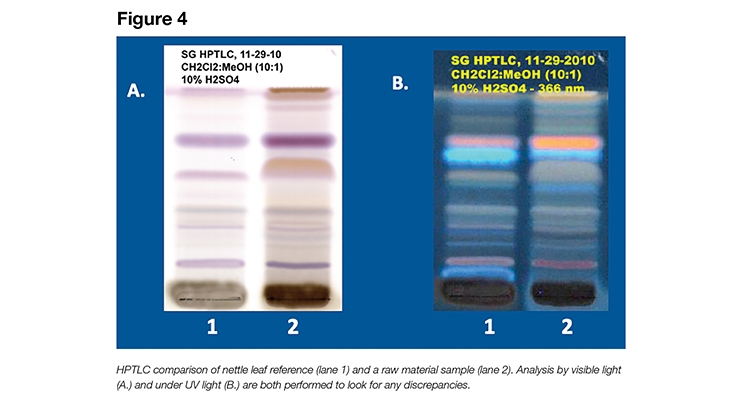
Origin Testing
One question both DNA and conventional chemical testing methods cannot answer is, “Where was my ingredient grown?” Another testing method has the potential to answer that question: isotope ratio mass spectrometry (IRMS).
This method measures the ratios of isotopes of carbon, nitrogen, sulfur, or oxygen, and compares them to references from specific regions in order to locate where the ingredient was grown. The same species will not have matching isotope ratios when grown in different regions due to differences in soil composition, sunlight availability and rainfall. This method may be limited if there is a lack of reference materials for an individual location, causing the material to be unidentifiable or misidentified.6
Using these same principles, IRMS can also detect adulteration that could not previously be identified. In honey, IRMS can detect if the manufacturer added sugar or high fructose corn syrup. Carbon in sugars originating from flowers is much higher in the isotope carbon-12, whereas sugars originating from sugar cane or corn are much higher in isotope carbon-13 levels.7 Therefore, if a honey sample has high carbon-13 levels, sugar or high fructose corn syrup has likely been added to it.
Conclusion
Choosing a fit-for-purpose tool for verifying a botanical material can be a daunting task, as there are many methodologies and they all have their strengths and weaknesses. If you are unsure of the best fit for your materials, take the time to research the pros and cons of each option. If you are still unsure of the best method for your products, consult the experts at a testing laboratory that you trust so that you can make informed testing decisions for your company—and most importantly, your customers.
References
1. Sanger, F., Nicklen, S., & Coulson, A. R. (1977). DNA sequencing with chain-terminating inhibitors. Proceedings of the National Academy of Sciences, 74(12), 5463–5467. https://doi.org/10.1073/pnas.74.12.5463
2. CBOL Plant Working Group, Hollingsworth, P. M., Forrest, L. L., Spouge, J. L., Hajibabaei, M., Ratnasingham, S., Little, D. P. (2009). A DNA barcode for land plants. Proceedings of the National Academy of Sciences of the United States of America, 106(31), 12794–7. https://doi.org/10.1073/pnas.0905845106
3. Zhang, N., Erickson, D. L., Ramachandran, P., Ottesen, A. R., Timme, R. E., Funk, V. A., … Handy, S. M. (2017). An analysis of Echinacea chloroplast genomes: Implications for future botanical identification. Scientific Reports, 7(1), 216. https://doi.org/10.1038/s41598-017-00321-6
4. Karni, M., Zidon, D., Polak, P., Zalevsky, Z., & Shefi, O. (2013). Thermal degradation of DNA. DNA and cell biology, 32(6), 298-301.
5. Reich, E. (2014) HPTLC for Identification of Herbal Raw Material and Extracts. www.scs.org.uk/document.aspx?fileid=2367
6. Camin, F. , Bontempo, L. , Perini, M. and Piasentier, E. (2016), Stable Isotope Ratio Analysis for Assessing the Authenticity of Food of Animal Origin. COMPREHENSIVE REVIEWS IN FOOD SCIENCE AND FOOD SAFETY, 15: 868-877. doi:10.1111/1541-4337.12219
7. L. Elflein and K.P. Raezke. (2008). Improved detection of honey adulteration by measuring differences between 13C/12C stable carbon isotope ratios of protein and sugar compounds with a combination of elemental analyzer – isotope ratio mass spectrometry and liquid chromatography – isotope ratio mass spectrometry (δ13C-EA/LC-IRMS). Apidologie, 39(5), 574–587.
Tools of the Trade
Sequencing, as a whole, has presented new opportunities to verify supply chains. Originally, Sanger sequencing brought identification of a single, dominant signal. This dominant signal can be aligned with a reference sequence and compared to determine the identity.1 Sanger sequencing is limited, however, due to its inability to identify anything beyond that single, dominant signal. This testing can act as a confirmation that your material contains the DNA of your target, but additional testing is required to find out if anything beyond the target you are looking for is present in the material.
From Sanger sequencing came next-generation sequencing (NGS). NGS technologies were developed to achieve a higher throughput than traditional Sanger sequencing, meaning that now we can produce thousands, if not millions, of sequences from multiple signals in a single experimental run. Different platforms in next-generation sequencing offer even more variability in the applications of DNA sequencing. Machine outputs can vary between 4 million to 20 billion reads. This quantity isn’t traditionally needed in standard identification but can be critical when looking to sequence a whole genome.
One commonly known method of sequencing is DNA barcoding, which can be used in Sanger and next-generation sequencing. DNA barcoding begins with extracting the DNA from a material and then amplifying target regions of the genome (genes) that will allow differentiation. Those genes are then sequenced for identification. Genes that have been traditionally sequenced for identification of plants include ribulose-1, 5-biphosphate carboxylase (rbcL), and maturase K (matK).2 Choosing the proper gene to identify your sample is imperative to ensure that a sample can be identified. See Figure 1 for an example of when one gene can be right for one genus, but not for another.

In the internal transcribed spacer region, you can easily distinguish these Panax species from one another. The differences between species are marked with a colored box. On the other hand, you cannot tell these Echinacea species from one another.
Figure 2 shows the exact opposite situation, where if you use maturase K then you are not able to tell the Panax species apart in this region, but you are able to distinguish the Echinacea species. These images were generated in Geneious version 9.1, which is created by Biomatters.

The other limitation, if the correct gene has been selected, is a database that has not been verified or monitored. Sources like GenBank can contain misidentified sequences as Figure 3 shows.
In Figure 3, we have an alignment of Iris species from GenBank, paired with two sequences of specimens from the UC Berkeley Jepson Herbarium. Iris loczyi from GenBank is clearly different from all other Iris samples, and when aligned with Brassica rapa samples from both GenBank and UC Berkeley Jepson Herbarium material, we can see that the sequence aligns perfectly. This demonstrates that not all databases are created equal, just as not all reference materials are created equal. These images were also generated in Geneious version 9.1, which is created by Biomatters.

Sanger sequencing and DNA barcoding are not, however, the only means of identifying a sample using sequencing. With the higher throughput of next-generation sequencing, we are able to sequence chloroplast genomes or even entire genomes. Chloroplast genomes have been found to be helpful for the identification of Echinacea in a study conducted by the FDA which may indicate future developments in the sequencing space.3
While the entire genome may not be necessary for identification, taking a deeper look into the genome can provide new information about the history of an organism or can even discover new similarities and differences among species. Long-read sequencing technologies are advancing rapidly, and have already shown significant improvements in costs, portability, and accuracy, which should eventually make whole genome sequencing a more financially feasible option.
Challenges & Solutions
Sequencing, whether it is Sanger, DNA barcoding, next generation or whole genome, has a significant limiting factor—DNA degradation. DNA degradation can occur for a number of reasons, but heat, chemical, or radiation treatments can all be major culprits.
As DNA is exposed to harsh treatments, the chemical bond weakens and ultimately breaks the DNA helix into small fragments, if not completely eliminating the strands. In one study, degradation starts around 130˚ C until complete degradation at 190˚ C. This study only conducted short trials of no more than 5 minutes but still saw significant degradation at high temperatures.4 While there is promise in using smaller genetic regions to identify lightly treated materials, sometimes sequencing is not the best way to identify a material. In these cases, analytical chemistry testing methods should be applied in identifying a specimen.
Chemical testing has a long-established history in authenticating botanicals and raw materials. Of the numerous methodologies available, high-performance thin-layer chromatography (HPTLC) is the primary chemical test for identifying botanicals. This is due to lower cost and higher resolution compared with other tests (HPLC, TLC, etc.).
The HPTLC test outputs a plate with bands unique to the chemical composition of the material being tested, which is then compared to reference standards to identify the material (Figure 4). If there is adulteration, contamination, or substitution in the material, the bands will not match up to the reference plate and more testing will need to be done in order to determine the culprit.5 Similarly, blends of more than one species present a challenge to the HPTLC methodology, as the bands contain more than one species and are hard to compare to the reference standards. Overall, HPTLC is a great choice for identifying materials and detecting contamination as it is accurate, cost effective and fast.

Origin Testing
One question both DNA and conventional chemical testing methods cannot answer is, “Where was my ingredient grown?” Another testing method has the potential to answer that question: isotope ratio mass spectrometry (IRMS).
This method measures the ratios of isotopes of carbon, nitrogen, sulfur, or oxygen, and compares them to references from specific regions in order to locate where the ingredient was grown. The same species will not have matching isotope ratios when grown in different regions due to differences in soil composition, sunlight availability and rainfall. This method may be limited if there is a lack of reference materials for an individual location, causing the material to be unidentifiable or misidentified.6
Using these same principles, IRMS can also detect adulteration that could not previously be identified. In honey, IRMS can detect if the manufacturer added sugar or high fructose corn syrup. Carbon in sugars originating from flowers is much higher in the isotope carbon-12, whereas sugars originating from sugar cane or corn are much higher in isotope carbon-13 levels.7 Therefore, if a honey sample has high carbon-13 levels, sugar or high fructose corn syrup has likely been added to it.
Conclusion
Choosing a fit-for-purpose tool for verifying a botanical material can be a daunting task, as there are many methodologies and they all have their strengths and weaknesses. If you are unsure of the best fit for your materials, take the time to research the pros and cons of each option. If you are still unsure of the best method for your products, consult the experts at a testing laboratory that you trust so that you can make informed testing decisions for your company—and most importantly, your customers.
References
1. Sanger, F., Nicklen, S., & Coulson, A. R. (1977). DNA sequencing with chain-terminating inhibitors. Proceedings of the National Academy of Sciences, 74(12), 5463–5467. https://doi.org/10.1073/pnas.74.12.5463
2. CBOL Plant Working Group, Hollingsworth, P. M., Forrest, L. L., Spouge, J. L., Hajibabaei, M., Ratnasingham, S., Little, D. P. (2009). A DNA barcode for land plants. Proceedings of the National Academy of Sciences of the United States of America, 106(31), 12794–7. https://doi.org/10.1073/pnas.0905845106
3. Zhang, N., Erickson, D. L., Ramachandran, P., Ottesen, A. R., Timme, R. E., Funk, V. A., … Handy, S. M. (2017). An analysis of Echinacea chloroplast genomes: Implications for future botanical identification. Scientific Reports, 7(1), 216. https://doi.org/10.1038/s41598-017-00321-6
4. Karni, M., Zidon, D., Polak, P., Zalevsky, Z., & Shefi, O. (2013). Thermal degradation of DNA. DNA and cell biology, 32(6), 298-301.
5. Reich, E. (2014) HPTLC for Identification of Herbal Raw Material and Extracts. www.scs.org.uk/document.aspx?fileid=2367
6. Camin, F. , Bontempo, L. , Perini, M. and Piasentier, E. (2016), Stable Isotope Ratio Analysis for Assessing the Authenticity of Food of Animal Origin. COMPREHENSIVE REVIEWS IN FOOD SCIENCE AND FOOD SAFETY, 15: 868-877. doi:10.1111/1541-4337.12219
7. L. Elflein and K.P. Raezke. (2008). Improved detection of honey adulteration by measuring differences between 13C/12C stable carbon isotope ratios of protein and sugar compounds with a combination of elemental analyzer – isotope ratio mass spectrometry and liquid chromatography – isotope ratio mass spectrometry (δ13C-EA/LC-IRMS). Apidologie, 39(5), 574–587.

